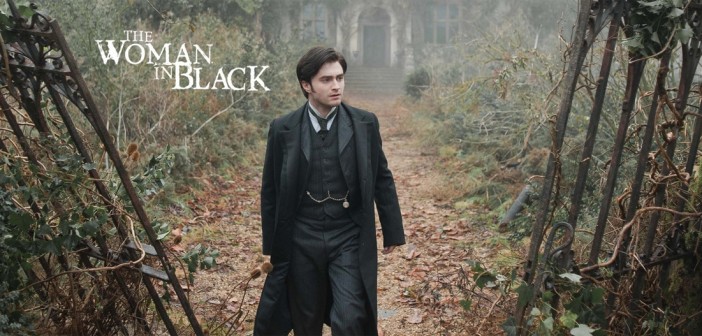A Hotbed of Haunted Hammer Horror
An early twentieth century setting. English marshland shrouded in fog. Rain, thunder, and lightning. A graveyard shrouded in ivy and dead twigs. A decaying mansion high atop a hill. Rooms blanketed in dust and cobwebs. Dark hallways faintly lit by candlelight. The sounds of whispers and crying bouncing off the walls. A shadowy figure stalking the premises. From the first frame to the last, The Woman in Black looks and feels exactly the way a horror movie should look and feel. I would expect nothing less from Hammer Film Productions, which gave us the British horror films of the 1950s and ’60s, many starring Peter Cushing and Christopher Lee. Here is a film that oozes atmosphere from every pore and keeps us on the edge of our seats in suspense.
Adapted from the novel by Susan Hill, the plot never ties to be anything more or less than a gothic Victorian ghost story, which in this case is not a drawback but a loving gesture on the part of the filmmakers. We’re not assaulted with crude slasher tactics like relentless gore, masked serial killers, and naked teenagers; instead, we’re made to savor the apprehension as it slowly gains momentum. Some of the pressure is relieved with an occasional pop out scare – throwaway gags to be sure, but effective nonetheless. Most of the time, however, it just keeps building, even when the story reaches its conclusion. When our hero slowly creeps his way down a dark passage with only a candle in his hand, we might think he’s crazy for even being in the house, but mostly we cling to our armchairs in sheer anticipation of something scary happening.
The hero is Arthur Kipps (Daniel Radcliffe), a young lawyer from London. He has a four-year-old son named Joseph (Misha Handley), who can never draw a picture of his father without giving him a frowny face. Indeed, he has had good reason be miserable since the death of his wife, whose memory haunts him as surely as the title character eventually does. But I’m getting ahead of the story. He’s sent to a faraway village to settle the legal affairs of a recently deceased woman. The villagers look on him dourly, as if he were a harbinger of doom. One man immediately scuttles his children inside their home as soon as he passes by. Upon meeting a landowner named Sam Daily (Ciarán Hinds), Arthur becomes aware that there has been a disturbing pattern of local children inexplicably killing themselves. It becomes more apparent when he meets Sam’s wife (Janet McTeer), who appears to possess the ability to channel the spirit of her son.
Arthur settles himself in the dead woman’s sprawling, dilapidated estate, which can only be accessed via a winding dirt road that disappears every evening with the tide. It isn’t long before strange things begin to happen. Noises are heard off in the distance. A door, which was locked at first, suddenly opens and reveals a nightmarish nursery, complete with a rocking chair that rocks on its own, mechanical toys that suddenly spring into motion, and a collection of dirt-caked dolls with dead, glassy eyes that stare off into space. Initially intact family portraits are obscured when the eyes of each subject are scratched off. Strangest of all is the continuous appearance and disappearance of a woman in a black dress. Sometimes she’s outside the estate, off in the distance by a makeshift cross sticking out of the mud. Unbeknownst to Arthur – for a time, at least – she will sometimes appear right behind him.
This woman, whom we know to be a ghost, has been woven into the fabric of local legend, her appearance signaling the impending death of another child. She does, of course, have her own tragic back story that’s right in line with this genre. No need to spell it out for you. Chances are you already have a pretty good idea. Regardless, the secret of the Woman in Black endangers not only the remaining children of the village, but also Arthur’s son, who’s scheduled to join his father at the end of the week. Despite the fact that Sam doesn’t believe in ghosts, he teams up with Arthur in a desperate attempt to stop the Woman in Black before it’s too late.
Although Radcliffe is given his fair share of dialogue, much of his performance is spent treading cautiously down hallways, slinking into creepy rooms, and running after figures hidden in fog or shadow. It all depends on his ability to react. And yet he never tries for the exaggerated pantomime of a silent movie actor; he relies almost entirely on his eyes, which perpetually express grief, surprise, fear, or any combination of the three. Through his gaze, we understand how we’re feeling at any given moment during the film, and it’s quite possible we will continue to feel that way even when the movie is over. The Woman in Black is not about cheap thrills, which are anonymous and fleeting. It’s about stirring within us the very fears we cling to as children. The fact that you’re older now doesn’t make the dark any less scary.

